August 4, 2017
Air Date: August 4, 2017
FULL SHOW
SEGMENTS
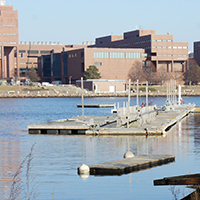
Boston in a Warmer World
View the page for this story
As a port city with low-lying areas, Living on Earth’s hometown of Boston, Massachusetts is particularly vulnerable to the sea level rise anticipated from global warming. So the City of Boston is arming itself with knowledge. The Mayor has commissioned a team of experts called Climate Ready Boston to report on future climate impacts. By the harbor’s edge at the University of Massachusetts’ Boston campus, hydrology professor Ellen Douglas and host Steve Curwood discuss the alarming implications of the report that she and an interdisciplinary group of academics put together. (09:35)
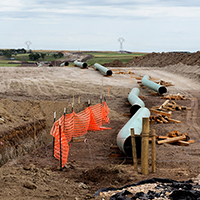
Big Plans For and Against Big Oil
/ Sandy TolanView the page for this story
North American oil and gas producers are rushing to build new pipelines as part of bid to gain more power in the international oil and gas markets, but they are running into fierce opposition at home. Reporter Sandy Tolan spoke with key players in the controversy, including residents of Louisiana'a Bayou country, where the hotly debated Bayou Bridge pipeline is still in the planning phase. (17:51)
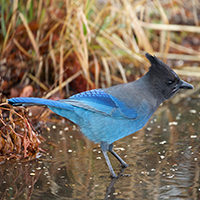
BirdNote: Steller’s Birds
/ Mary McCannView the page for this story
Some birds’ names reflect their habitat, like the Sage Grouse, or, like the Chickadee, their song, but as Mary McCann comments, some memorialize intrepid bird-lovers like Georg Wilhelm Steller. (02:00)
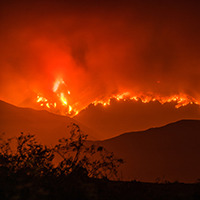
Land On Fire
View the page for this story
The impact, devastation, and cost of forest fires in America’s West has multiplied in recent decades. Wildfires now blaze fiercer, hotter, and longer than ever before, tearing through communities and overwhelming the forest service budget. Rising temperatures, partly driven by global warming and longer drought seasons have encouraged more insect attacks, and turned western forests into easy kindling for raging megafires - yet people keep building homes in the danger zones. Nature writer Gary Ferguson sits down with host Steve Curwood to discuss his new book, Land on Fire, the new reality of wildfire in the West, and important tips for homeowners to help protect their property and lives. (15:39)
Show Credits and Funders
Show Transcript
HOST: Steve Curwood
GUESTS: Ellen Douglas, Gary Ferguson
REPORTERS: Sandy Tolan, Mary McCann
[THEME]
CURWOOD: From Public Radio International, this is Living on Earth.
[THEME]
CURWOOD: I’m Steve Curwood. Planning for a wetter future in Boston, thanks to global warming.
DOUGLAS: What really is troubling is, towards the end of the century where we could see anywhere from 4 to 7 feet or as much 10 feet of sea-level rise. You know, that’s the maximum estimate assuming all possible things go wrong at the same time, but still that’s a lot of water.
CURWOOD: What to expect with climate change and how to adjust. Also backers say the push for pipelines is a bid for dominance by North American fossil fuel companies.
ar
CRAMER: I view us as a North American energy bloc that rivals, if not exceeds, the global market potential of OPEC, and that's where the Dakota Access Pipeline comes in. That infrastructure has to, of course, involve moving oil to the coasts and having export terminals and all that.
CURWOOD: Those stories and more, this week on Living on Earth. Stick around.
[NEWSBREAK MUSIC: Boards Of Canada “Zoetrope” from “In A Beautiful Place Out In The Country” (Warp Records 2000)]
[THEME]
Boston in a Warmer World
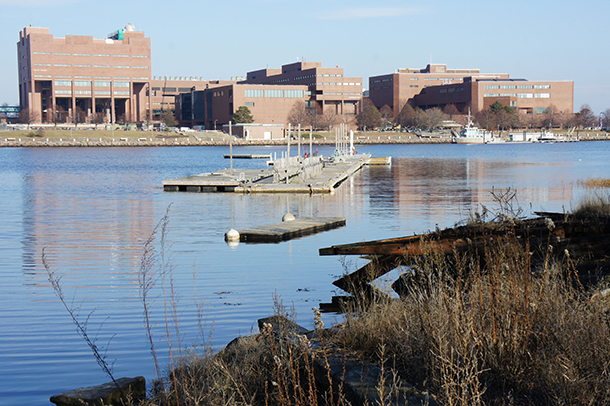
UMass Boston’s campus, the home of Living on Earth, is about twenty feet above the high-tide level. (Photo: UMass Boston Photos)
CURWOOD: From PRI, and the Jennifer and Ted Stanley Studios at the University of Massachusetts Boston, this is Living on Earth. I'm Steve Curwood.
And we're in our front yard -- or maybe our backyard -- because here at the University of Massachusetts, where we are in Boston, we are on Boston Harbor. And joining us right now is UMass Boston professor Ellen Douglas. She's a hydrologist who's been studying what could happen to the city of Boston as climate change advances.
Welcome to Living on Earth.
DOUGLAS: Thanks. Happy to be here.
CURWOOD: First, tell me, what inspired local leaders to form the team that’s called Climate Ready Boston?
DOUGLAS: Well, it’s been a long time in coming. The city has been working on climate change adaptation and mitigation for a while, but in 2012, when Sandy really devastated New York City, it made a lot of people in Boston realize that we dodged the bullet and that we need to make sure that we're prepared for the event, if something like that happened here.
CURWOOD: So, you have a good size team, what, 20 of you who’re working on this project at various institutions. Talk to me about the disciplines that they bring to the table.
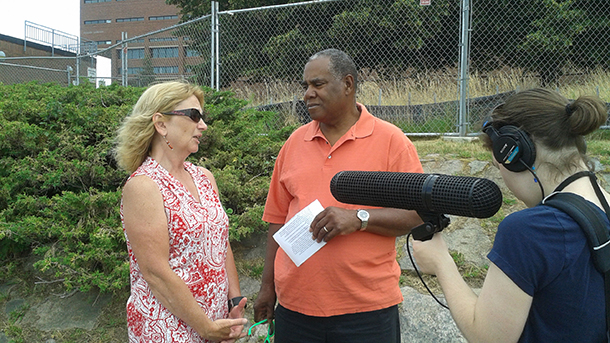
Hydrologist Ellen Douglas gives Living on Earth host Steve Curwood the bad news about the anticipated climate impacts that lie ahead for the city of Boston, as Jenni Doering records. (Photo: Helen Palmer)
DOUGLAS: Yeah, we had quite a variety. It was really, really quite exciting and very educational too, to work with all these people. We had oceanographers. We had climatologists. We had meteorologists. We had hydrologists. We had engineers, oh, atmospheric scientists, climate scientists, economists. We had people working in consulting firms. We had people from Harvard and Northeastern and Boston University, all the local universities, so the list is almost endless. [LAUGHS]
CURWOOD: Because I guess this touches every part of society.
DOUGLAS: It does, it does. It’s not even just the physical sciences. It’s the social sciences and the economics as well.
CURWOOD: So here we are, on the edge of the Harbor in Boston. Now, I'm told that the campus itself is almost 20 feet above sea level, the main buildings, but of course we're down on the walkway by the boats, where, oooh, when the tide is up, it’s got to be just six feet away from us. Okay, Ellen, you can tell us. [DOUGLAS LAUGHS] What would happen if Sandy had come here to Boston? What would it be like for us out here at this campus, this harbor?
DOUGLAS: Well, while we were standing on the harbor walk, we probably would've gotten feet wet. Campus itself, as it exists right now, amazingly, is above even the highest of the scenarios that we looked at, as far as water levels; however, you wouldn’t be able get on or off campus [STEVE LAUGHS] because all of Harbor Point area and Morrissey Boulevard entrance would be completely submerged, so it would be kind of like an island at that point.
CURWOOD: So let's get out of our backyard. Talk to me about the bad news here. How much sea level rise is projected in Boston in the coming decades? What are we looking at for the city as a whole?
DOUGLAS: Well, at about mid-century we could be looking at anywhere from, you know, six inches, eight inches up to a foot or so. What really is troubling is, towards the end of the century, where we could see anywhere from four to seven feet or as much as ten feet of sea level rise. You know, that's the maximum estimate, assuming all possible things go wrong at the same time, but still, you know, that's, that's a lot of water.
CURWOOD: So people who’re curious about what that would do the Boston and want to see this visually can go to our website, loe.org, and see the wonderful map that you guys put together, or I should say maybe it’s a terrifying map. But for folks who are listening, just describe what happens to Boston, say, with ten feet of sea level rise.
DOUGLAS: ten feet of sea level rise, you end up with South Boston flooded, the financial district flooded, and the Charles River dam can be over-topped or short-circuited so that water gets back behind it into Back Bay and Cambridge, so a very large part of the city that's not used to getting wet would be wet.
CURWOOD: And I imagine, as a hydrologist you’ve looked at other places that have dealt with this. I’m thinking, of course, of Holland. I’m thinking of the part of the Netherlands that's underwater already and other places in the world.
DOUGLAS: Yeah, well, actually as part of the Climate Ready Boston, interestingly enough, they sent a contingent of people from Boston to the Netherlands, to Denmark, to those communities who have been dealing with this kind of issue for centuries to get some ideas and some suggestions and advice.
CURWOOD: Now, there’s more to climate change than just rising sea level, of course. We're recording this just as summer is really starting to heat up, and in your report you say the summers are already getting hotter here in Boston. So, how much hotter is hotter, and what kind of heat is ahead?

Light blue areas on this map show the parts of Boston that could be inundated under five feet of sea level rise. (Photo: produced using NOAA’s Sea Level Rise tool at https://coast.noaa.gov/slr/)
DOUGLAS: The average temperatures, I think, are going to go up eight to ten degrees. What really is troubling is the number of days above 90 degrees and above a hundred degrees that we're just not used to here in the northeast. Typically days above 90 degrees, we get about 11 a year, and by the end of the century, under the highest emissions scenario, that could be as many as almost 90 days a year which is like a full summer’s worth of heat wave.
CURWOOD: Over how many degrees?
DOUGLAS: 90 degrees.
CURWOOD: Oh, my.
DOUGLAS: Yah, heat extremes are a big concern as well as sea level rise.
CURWOOD: I was going to say, people die when it gets that hot.
DOUGLAS: Yes, yes.
CURWOOD: In Chicago, for example, in a heat wave not so long ago, a number of people died.
DOUGLAS: Yah, and it's not even just the number of days, but it's the number of consecutive days, so after about three to five days, you know, cooling systems actually they just can't keep extracting the heat, and so a lot of air conditioning systems begin to not work as well and as efficiently, and it's a real concern health-wise when you're looking at that kind of temperature.
CURWOOD: Water, heat, this is not a positive scenario.
DOUGLAS: No, sad to say, it’s not.
CURWOOD: So, what about other eastern seaboard cities? How much trouble do they face from climate disruption compared to Boston, do you think?
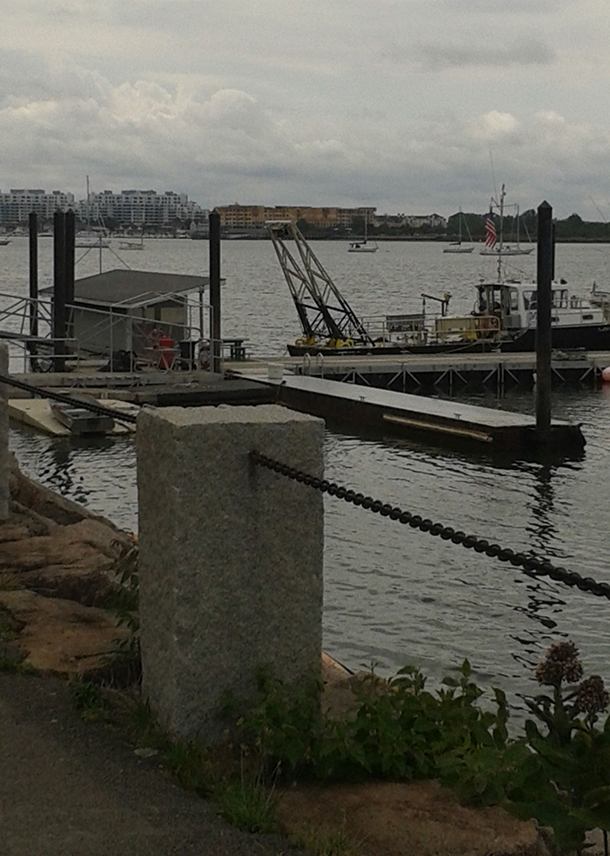
Savin Hill Cove borders the UMass Boston campus (Photo: Helen Palmer)
DOUGLAS: Well, pretty much everybody along the coast, they're facing similar issues. Here in Boston, in some ways we have an advantage because we have a very high tide range. So it’s a ten foot tide range, so a lot of our infrastructure is built for this big range. In New York City, their tide is only like four feet, two feet up and two feet down, and so that's why when you got a big storm surge on top of their minimal tide range, it really caused a lot of devastation. Here, if a five foot storm surge hits in Boston, which is our extreme storm surge at low tide, we might not even notice. And that all depends on where you are on the coastline.
CURWOOD: So we’d better not have a full moon and high tide when the next big storm surge comes.
DOUGLAS: Yeah, that's exactly what happened in New York City. The highest high tide and a record storm surge hit at exactly the same time.
CURWOOD: Tell me, why is it important to engage with the Office of the Mayor here on the issue of climate change in Boston?
DOUGLAS: Well, they’re the movers and shakers, right? He’s the one that makes the proclamation that says, “This is a priority for Boston,” and tries to bring people in line, and when you’ve got them on your side then it’s a lot easier to get things done.
CURWOOD: So Boston is about 400 years old. In another 400 years, is there a Boston as we know it?
DOUGLAS: Well, not as we know it, for sure. It’s hard to say. I mean, even in another 200 years there could be parts of Boston that are under water, and so you’re going to have to deal with that either by putting up some sort of protective barriers or building buildings higher or whatever, but it's definitely not going to look like it does today.
CURWOOD: Your task force is moving ahead to prepare a vulnerability assessment and look at some resilience strategies. How do you put that together?
DOUGLAS: Well, the teams that are working on that right now have done a lot a lot of data mining, looking at reports and data that are already existing, to pull it together, integrating it into the strategy that the city wants to take. A big part of it is outreach to communities, to figure out what they're most worried about, and bring in not just city itself but the agencies like Massport, MBTA, and Mass DOT, and all the agencies are, are figuring out how their infrastructure is going to be impacted, how their operations are going to be impacted, and it's a matter of figuring out how you're going to work that into the long-term plan. We have time, which is the good news. We have some vulnerability now, but the agencies have time to integrate this into their long-term planning, as far as upgrading their infrastructure or building new infrastructure for protection and for flood-proofing, things like that.

Ellen and Steve spoke on the UMass Boston Harborwalk by Savin Hill Cove (Photo: Helen Palmer)
CURWOOD: In the immediate future what do you think’s the biggest risk of a climate event here?
DOUGLAS: Probably a big coastal storm. I mean, we're right here on the coast, and not so much a hurricane -- We don't get hurricanes as often as you think -- but a big Nor'easter like we saw in ’91, you know, the “no-name storm” or the “perfect storm”? That actually caused the largest storm surge we’ve seen, so that's probably the most likely in combination with a lot of precipitation.
CURWOOD: So this is not so much the future but really now.
DOUGLAS: Yuh, yuh, I think we're seeing that pretty much everywhere in the country and the world.
CURWOOD: How many folks understand that this is an emergency and that people need to move, not just fast, but really fast?
DOUGLAS: Yeah, that is a challenge. We’ve thought of climate change as this long-term impact, but observations over the last decade have showed us that, yes, there’s long-term impacts, but there's also impacts that are occurring now and things are happening faster than we expected so that is a challenge. And I guess nature sort of helps us out in that way, if you can think of it that way, by, you know, all the flooding and the Super Storm Sandys and things like that definitely get people’s attention.
CURWOOD: For example, right now as we're talking here in Boston, there are wildfires in, I don't know how many states, so it's pretty intense right now.
DOUGLAS: Well and the thing that’s striking is the number of times you hear “record-breaking” and, you know, statistically speaking, records will always be broken, but the time between records is supposed to increase, but records are being broken over and over and increasingly faster, and so that's what makes realize that the climate is changing too, is because everything that happens seems to be a record event.
CURWOOD: Professor Ellen Douglas teaches hydrology at the University of Massachusetts, Boston. Ellen, thanks so much for taking the time today.
DOUGLAS: Oh, this was fun. Thank you.
Related links:
- Climate Ready Boston
- Read the Climate Projections Consensus on anticipated climate impacts in Boston
[MUSIC: Ole Kock Hansen/Thomas Fonnesbaek, “Natten Er Sa Stille (The Night Is So Quiet),” on Fine Together-Nordic Moods, C.E.F. Weise, Stunt Records]
CURWOOD: Coming up, the oil business began in America, and there’s a bid to make America the home of big oil again.
[CUTAWAY MUSIC: Edgar Meyer with Bela Fleck and Mike Marshall, “Zigeunerweisen” on Uncommon Ritual, composed by Pablo Sarasate/arr.Edgar Meyer, Sony Masterworks]
Big Plans For and Against Big Oil
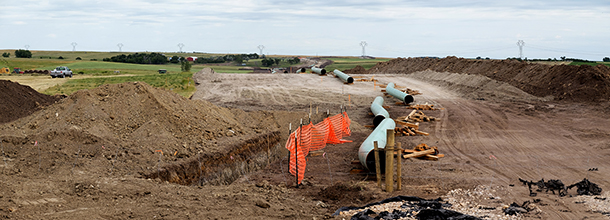
The Dakota Access pipeline under construction. (Photo: Lars Plougmann, Flickr CC BY-SA 2.0)
CURWOOD: It’s Living on Earth, I’m Steve Curwood.
In the early spring last year Native activists rode their horses through the snow to the edge of the Cannonball River on the Standing Rock Sioux reservation, pledging to kill the “black snake,” the nearly 1200 mile long Dakota Access Pipeline –“DAPL.” Well, that fight was lost, as in May thousands of barrels of fracked crude oil began flowing through that pipeline, heading to a terminal in Illinois, and then down toward the U.S. Gulf Coast.
But Native and climate change activists say the struggle against DAPL was just one battle in a much longer war, with a dozen more Standing Rocks on multiple front lines across America, as companies race to lay pipelines as quickly as possible. Campaigners warn the U.S. is becoming a “petrostate.” U.S. climate commitments they say, and the very health of the planet, are at stake. Living on Earth contributor Sandy Tolan spent months investigating the new oil wars. Here’s his report.
[POLICEMAN ON BULLHORN, CROWD SOUNDS]
TOLAN: For 10 months, thousands of overwhelmingly peaceful protesters stood on the front lines at Standing Rock. They endured tear gas, rubber bullets, hypothermia, and vilification by the police and local media.
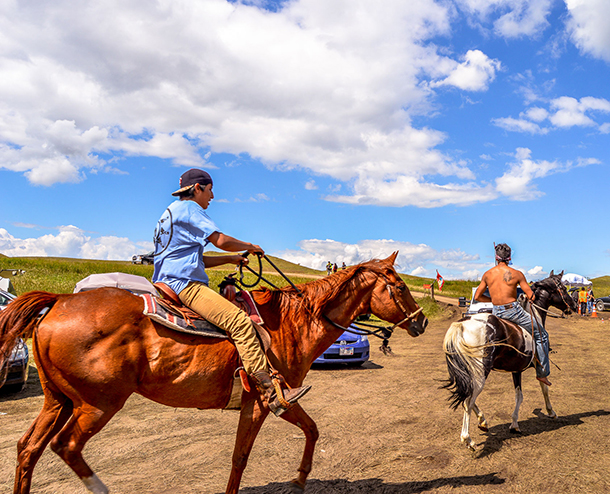
Two Standing Rock demonstrators take to horseback as part of the Standing Rock demonstrations that peaked in 2016. (Photo: Robert Wilson)
MAN ON BULLHORN: First of all, we need to know, these protestors that are here, right now, eighty-five percent of them, based on the arrests so far, are from somewhere else. OK? They’re not from North Dakota. And if we follow the money of who’s paying them to get here, I want an investigation not unlike we do in a drug crime, not unlike we do in some terror, because they are terrorists...
OTHER MAN ON BULLHORN: You need to get out now…
TOLAN: In my five trips to North Dakota over the fall and winter, I was always struck by the intensity of the police and private security companies’ response -- the dog attacks, the hoses dousing protesters in sub-freezing temperatures, the metal detention cages modeled on dog kennels, the numbers scrawled on the forearms of the people they arrested. These seemed like tactics from another era or another country. I wondered why North Dakota was so intent on not losing the fight over the Dakota Access Pipeline.
[HELICOPTER]
POLICEMAN ON BULLHORN: If you do not comply, you will be arrested for violations of North Dakota laws. Please disperse now.
TOLAN: Turns out, officials here were protecting a grand plan worth tens of billions of dollars. In that plan, the Dakota Access Pipeline, DAPL, is North Dakota’s linchpin. It allows a glut of fracked oil from the massive Bakken formation to flow southeast toward the US Gulf Coast. Bakken oil is part of, what boosters call, the “North American petroleum renaissance.” The US is now the world’s third largest producer of crude oil, pumping more than Iran and Iraq combined.
North Dakota Republican Congressman Kevin Cramer says, that means opportunity.
CRAMER: We have the potential to produce all we need and then some.
TOLAN: Cramer is a champion of DAPL and a climate change skeptic.
CRAMER: I view us as a North American energy block that rivals, if not exceeds, the global market potential of OPEC.
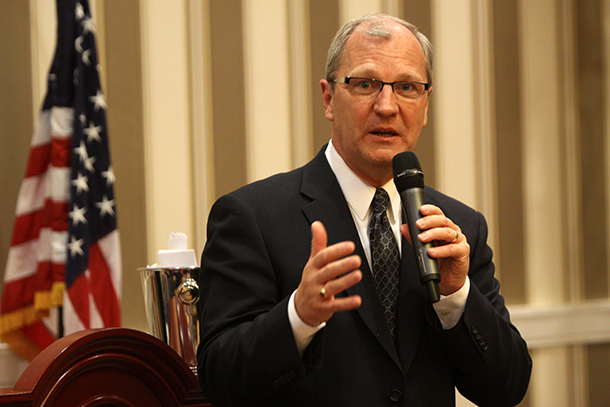
Republican Congressman Kevin Cramer is a proponent of pipelines as a means of transporting crude oil. (Photo: Gage Skidmore, Flickr CC BY-SA 2.0)
TOLAN: But if that’s to happen, Cramer says, North Dakota producers can’t keep shipping fracked oil by expensive rail to the east coast. They need more efficient means.
CRAMER: And that's where the Dakota Access Pipeline comes in. That infrastructure has to, of course, involve moving oil to the coasts and having export terminals and all that.
TOLAN: “Export terminals.” You heard the Congressman right. Kevin Cramer says the Dakota Access Pipeline will carry oil for export.
CRAMER: So, yeah, I think Bakken crude is destined for the world.
TOLAN: Yet DAPL, Keystone XL, and other controversial projects were justified in part in the name of American “energy independence.” Lorne Stockman of the watchdog group, Oil Change International, says that’s a line of bull.
STOCKMAN: The oil and gas industry is sort of wrapping itself in the flag and talking about energy independence, when actually what they're doing is turning the country into a resource colony for export of oil and gas.
TOLAN: So, the pipeline company Energy Transfer, backed by North Dakota officials, police, and the National Guard, fought that huge battle at Standing Rock, in large part so that US crude oil could leave the country.
CRAMER: We now get to play in the global marketplace.
TOLAN: For 40 years that was illegal. During the Arab oil embargo, Congress imposed a ban on crude oil exports. Only American oil destined for Canada could leave US shores. But, with all that fracking in North Dakota and Texas, the shale oil revolution changed the game completely.
HEITCAMP (on CNBC): And so North America is going to become the energy powerhouse for the world...
TOLAN: And Senators like North Dakota’s Heidi Heitcamp, a Democrat, started showing up on the business talk shows, along with oil executives, saying it was time to turn American oil loose.
HEITCAMP (on CNBC): And if you don’t allow the exports of this oil, they’re going to re-invest someplace else where they can market their oil.
TOLAN: And so in December 2015...
NEWS ANCHOR1: There is a big move in Washington as Congressional leaders have agreed to lift the nation’s 40-year old ban on oil exports...
TOLAN: Now, more and more, exhaust from American crude oil is destined to spew from tailpipes in Amsterdam, Beijing, Tokyo, even Caracas. Every day this February nearly 300,000 barrels of American oil went to China.
NEWS ANCHOR2: China became the biggest buyer of US crude in February. The country imported over eight million barrels…..
TOLAN: Ironically, all this is happening as demand for oil in the US and other Western countries is flattening. You may wonder, then, why there’s a massive buildout of tens of billions of dollars in pipelines, oil storage tanks and export terminals. Perhaps that’s because of skyrocketing demand in the developing world.
Lena Moffitt, director of the Sierra Club’s Beyond Dirty Fuels campaign, says the two go together.
MOFFITT: I think that they’re playing the long game, in that they are teeing things up to ensure that not just the United States, but the globe, stays reliant on oil for as long as possible.
TOLAN: Oil companies have seen the writing on the wall, Moffitt says, and they’re moving as quickly as they can.
MOFFITT: To lock in continued demand for product via this infrastructure. The industry is in, you know, a race to secure the export terminals and the pipelines that will get these fossil fuels to our coasts as fast as possible.
TOLAN: And yet, just as DAPL is but one big pipeline amidst a sea of new infrastructure, so was Standing Rock only one battle in a long war. Activists are taking to the front lines from Vancouver to Maine, from Minnesota to Oklahoma to Louisiana’s bayou country.
FOYTLIN: In these troubling times, where we're seeing such an assault upon water and earth, on our communities, I don't feel like anyone has the opportunity to slack or lay off.
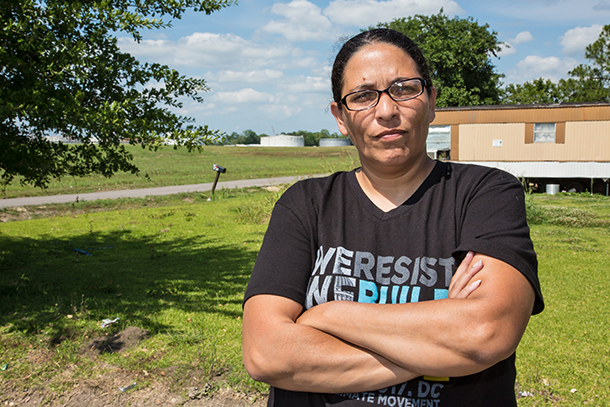
Cherri Foytlin on Burton Lane, in St. James Parish, where the Bayou Bridge Pipeline will end if built. The oil storage tanks in the background are close to locals’ homes. (Photo: Julie Dermansky / Reveal)
TOLAN: I’m heading into Bayou country with Native activist Cherri Foytlin in her SUV, rolling past gleaming white cylinders -- crude oil tanks – part of that massive new infrastructure. Foytlin is raising six kids in a small town 150 miles west of New Orleans. But as state director of the Bold Alliance, she’s spending a lot of time on the road these days, fighting pipelines, especially the proposed Bayou Bridge.
FOYTLIN: This is like the continuation of assaults against our communities. We have so many pipelines in our state and so many accidents and so many leaks.
TOLAN: The Bayou Bridge would be built by Phillips 66, Sunoco, and Energy Transfer.
FOYTLIN: …Which is the same corporation who had committed human rights violations in Standing Rock in North Dakota. Their plan is to put in a pipeline that runs from Lake Charles to St. James across 11 parishes, including my own parish, where I live, and 700 bodies of water right down there in south Louisiana and the wetlands.
[SLAMMING CAR DOOR AND FOOTSTEPS]
TOLAN: Foytlin pulls up where a gravel road meets the softly lapping waters of a lake. We walk to the water’s edge.

Wetlands near the route of the proposed Bayou Bridge pipeline south of Lake Charles, Louisiana. (Photo: Karen Savage / Reveal)
FOYTLIN: We’re standing on the edge of some beautiful wetlands. You can see birds. That’s a wood duck flying over. I saw a pelican here just a few minutes ago.
TOLAN: In the distance refineries belch smoke and orange flares.
FOYTLIN: The Bayou Bridge pipeline is going to go right through this body of water, right through those wetlands right there.
TOLAN: The Bayou Bridge recently cleared one regulatory hurdle, and now it’s closer to reality. Despite the complex social dynamics between Louisiana’s oil industry workers, fishermen, and local communities, energy has generally held sway here. Yet, back in the car, Foytlin tells me that in the age of Trump and Standing Rock, something has changed. Not long ago, two or three people would show up to protest a new energy project. But now...
FOYTLIN: We had a solidarity action for Standing Rock and several hundred people showed up, and that's, that’s historic for us. Yeah, we had two hearings, and in one case we had about 400, 450 people. We're definitely seeing a shift in awareness, in consciousness, and in people taking action.
TOLAN: It’s the same story at dozens of pipeline battles across the country. Activists, inspired by Standing Rock and spurred by Trump, are mobilizing. Sierra Club Washington lobbyist Athan Manuel says, that’s a big thing.
MANUEL: These pipeline fights are really, really important because we need to cut off the economies of scale for them, and stopping those pipelines is one way to do it.
TOLAN: But the economy of scale of the American oil renaissance, and the power behind it, is huge. So much more oil is pumping out of US wells, compared to just 10 years ago, that the very flow of it has reversed direction.
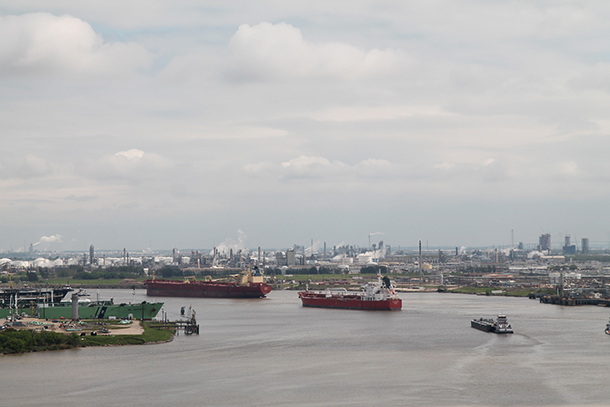
Existing industry dominates the skyline in Lake Charles, Louisiana. (Photo: Karen Savage / Reveal)
BRAZIEL: So, you want to know how crude oil moves. Most of the crude oil in the United States moves right there.
TOLAN: A silver-bearded Texan in jeans and cowboy boots leans over a table in the high-rise conference room of his company, RBN Energy.
[SOUND OF UNROLLING A MAP]
BRAZIEL: There was a time when a lot of crude moved up from this area.
TOLAN: Rusty Braziel unfurls a giant map labeled “US GULF COAST CRUDE OIL INFRASTRUCTURE.” He traces his finger from Louisiana toward Cushing, Oklahoma, the “pipeline crossroads of the world.”
BRAZIEL: With all of the production that kicked in, in both Canada and in North Dakota, and now a lot of that crude moves back down this way.
TOLAN: His finger reverses, moving back toward the Gulf, and all its new terminals and storage tanks. But Braziel’s a bit of a contrarian. He doesn’t think much of this oil is leaving the country any time soon. For one thing...
BRAZIEL: We still import about seven million barrels a day, net imports. Now, we have to bring in a barrel for every barrel that goes out.
TOLAN: So, he’s skeptical of all the export talk. For starters, it has to make economic sense.
BRAZIEL: So, it costs me money to ship it there, right? So if I put it in a ship here, and I get the same thing for it there that I could have sold it for here, but I had to pay $2 to get it there, why would I do that?
TOLAN: In the year after the export ban ended, Braziel shows me on his laptop, exports hardly ticked up at all.
BRAZIEL: It’s nothing. It’s nothing. Nothing happened.
TOLAN: But more recently buyers in Japan, Singapore, and China are beginning to pay more for American oil than producers can get back home, especially after OPEC cut production last year. This year for the first time US exports topped a million barrels a day, double that of a year ago. The American petrostate is flourishing, just as the planet is warming.
[DRUMMING]
TOLAN: And the cherry blossoms along the National Mall are blooming earlier and earlier.
GEMMILL: The very ground we walk on is melting beneath our feet.
TOLAN: Native activist Faith Gemmill sits on a patch of grass on a mild March afternoon, in the shadow of the Washington Monument. She’s come with thousands of others to stand with Standing Rock and to move on to other struggles, for example, in her native Alaska.
GEMMILL: There’s actually communities that are on the coastline that need to be relocated immediately. It’s an urgent situation because the ice melting has allowed the erosion of the coastlines. And that's going to be the reality of other coastal communities anywhere in the US eventually, if we don't raise the profile of catastrophic climate change.
TOLAN: Gemmill is part of the Indigenous Environmental Network. She sits beside six large teepees across the mall from the Capitol building. Activists have been lobbying sympathetic senators like former Democratic presidential candidate Bernie Sanders.
[VOICES IN A CROWD]
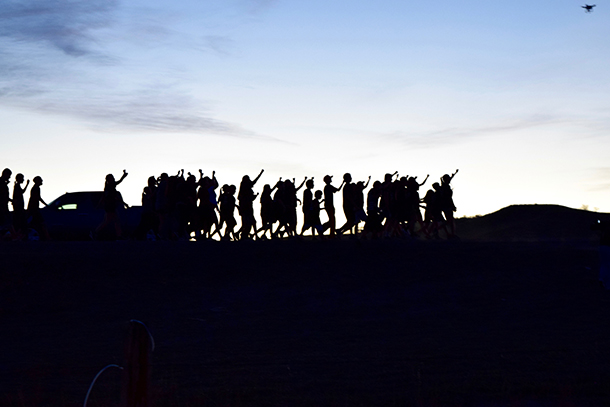
A group of youth demonstrators marching from Cannonball River to the Oceti Sakowin Campground. (Photo: Jacqueline Keeler)
TOLAN: And now Oregon Democratic Senator Jeff Merkley ducks into one of those teepees, and in his grey pinstripe suit plunks himself on the dirt. He sits in a circle among two dozen natives, all with their own stories of energy disasters on their homelands. Dallas Goldtooth was a leader in the battle against DAPL.
GOLDTOOTH: A lot of us are coming here to this camp that has been spearheaded by this fight against Dakota Access pipeline. But it’s not just one pipeline we're fighting against. It's not just Standing Rock. It's this global effort to keep fossil fuels in the ground and build really good solutions.
TOLAN: Merkley sits and listens for half an hour. He looks around the teepee, talking about his own “Keep It In the Ground” bill for federal land.
MERKLEY: By 2050, we must completely replace our fossil fuel energy economy with clean and renewable energy.
TOLAN: But, he says, not much will happen in Washington any time soon. The fight is local, and it’s long term.
MERKLEY: The fossil fuel industry largely owns Congress. They've invested bazillions of dollars in campaigns to control the Senate and the House. So, our response to that has to be to bypass the federal government, go directly to every local organization and say, “Let’s own this problem at the grassroots level, and let's act.” That is a grassroots strategy because we cannot wait for the US government.
TOLAN: Outside the teepee, I see a young Navajo woman I’d met at Standing Rock. Vanessa Dundon, who goes by Sioux Z, was badly injured during the clashes with police when she was shot in the eye by a tear gas canister. Since then, she tells me, she’s had three surgeries, but still has only 10 percent vision in her right eye.
SIOUX Z: And I still have a few more surgeries.
TOLAN: But Sioux Z is more interested in talking about where the fight will go from Standing Rock.
SIOUX Z: It was really hard. Because we all fought so hard, but we’re still here, and we spread the fire.
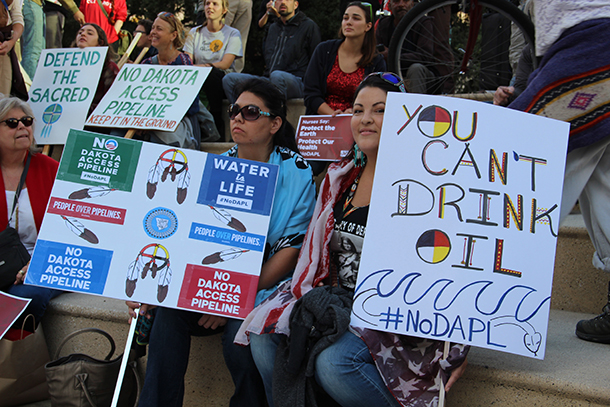
Local demonstrations against the Dakota Access Pipeline sparked protests in Oakland, California, and dozens of other places around the U.S. (Peg Hunter, Flickr CC BY-NC 2.0)
TOLAN: She means that literally. Embers from the sacred fire in Standing Rock are being carried to other pipeline battles across the country, where they light up new struggles.
SIOUX Z: I've been to a few pipelines since I’ve seen you. I went to Texas. I went to the Pilgrim Pipeline up in New Jersey, and the one in Iowa just started. I want to go check them out too before I head back to Florida, where I've been to two of the camps there. I’m planning on going to Oklahoma. They're going to light their fire next week.
[FOOTSTEPS AND CROWD NOISE IN THE BACKGROUND]
TOLAN: The fire has also spread, if only symbolically, to a white Southern woman on a lonely six acres of land in Louisiana’s bayou country.
[WALKING]
ROSINSKI: We are walking in my backyard.
TOLAN: Hope Rosinski, a single mom, owns a home in the path of Energy Transfer’s Bayou Bridge pipeline, the last leg that begins with the Dakota Access, 15 hundred miles north.
ROSINSKI: But this is basically right here where the Bayou Bridge wants to come through.
TOLAN: Rosinski says she won’t let the pipeline company cross her land in Louisiana’s Acadia Parish on its way to an oil terminal in St. James.
ROSINSKI: This is the right of way that pipeline came through -- I guess the end of ’15 -- and I've been battling them for the past year. They've offered me money for an easement. I don't want them to come through.
TOLAN: Representatives of Energy Transfer have tried to cajole Rosinski with friendly talk, entice her with money, and threaten her with eminent domain. Finally, in March the company served her with a “petition for expropriation.” Still she’s not budging.
ROSINSKI: And I see things differently. I was very naive as to what goes on with these oil companies, and I don't want any part of it. I think that human life is much more important than a dollar. We can be okay without all that oil.
TOLAN: But the America First energy players are in power now, targeting what they say is $50 trillion in untapped petroleum. And so all that oil will flow through all those pipelines, toward all those export terminals, no matter how hot the planet gets. Unless, of course, activists like Hope Rosinski can find ways to stop them.
ROSINSKI: I’m just waiting. Hoping and praying that we win. It’s time.
[SOUNDS OF THE OUTDOORS]
TOLAN: For Living on Earth, this is Sandy Tolan.
Related links:
- The Times-Picayune: “With Bayou Bridge Pipeline, Louisiana again weighs oil, environment”
- Indigenous Environmental Network
- Army Corps of Engineers: About the Bayou Bridge Pipeline
- Bold Louisiana Bayou Bridge Updates
- An LOE report from Sandy Tolan about the Dakota Access Pipeline
- This story is part of the “Chasing Energy” series, produced by Reveal from the Center for Investigative Reporting
- Reveal Center for Investigative Reporting | More from Tolan on Pipelines
BirdNote: Steller’s Birds
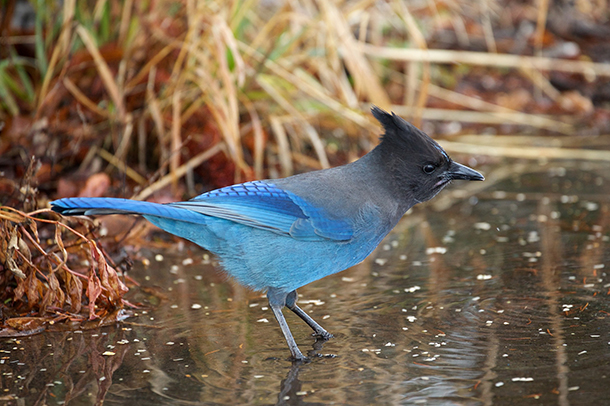
A Steller's Jay, named for Georg Wilhelm Steller, the first European to set foot on the land later known as Alaska. (Photo: Gregg Thompson)
[MUX - BIRDNOTE® THEME]
CURWOOD: Many birds are named for the place they live --- think the Sage Grouse – or for the sounds they make – like the Chickadee. Then there are some, as Mary McCann reminds us, that memorialize ardent birdwatchers and bird-lovers.
http://birdnote.org/show/stellers-birds
BirdNote®
Steller’s Birds
[Steller’s Jay calling]
This loud, raucous call belongs to a common jay of the Western states, the Steller’s Jay.
[Steller’s Jay calling]
You might mistakenly call this bird a Blue Jay, seeing its bright cobalt-blue body. But when the Steller’s Jay was first discovered, the name “Blue Jay” had already been assigned to a different species of jay living in the Eastern United States
You might guess that the word “Steller” describes an exceptional jay, [Steller’s Jay scolding] but Steller, spelled s-t-e-l-l-e-r, comes instead from a man’s name.
It was back in July of 1741 that Georg Wilhelm Steller, the first European to set foot on land later known as Alaska, first sighted this jay. Steller was a German naturalist on the St. Peter, a Russian ship exploring the Bering Sea.
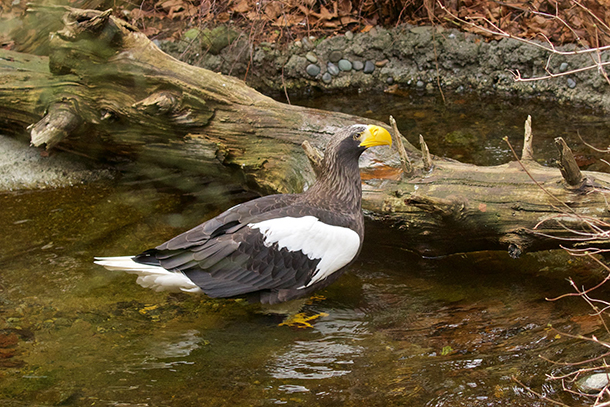
The Steller’s Sea Eagle also bears the name of the adventurous German naturalist who explored the Bering Sea on the St. Peter. (Photo: Gregg Thompson)
[Waves and creaking of a ship]
Shortly after finding and describing this jay, Steller was shipwrecked on Bering Island for over a year. After enduring a harsh winter and rebuilding their boat, the few survivors, including Steller, returned to Russia.
Steller wrote a book about the creatures that lived on the island. Many were later named for this adventurous and feisty German, among them the Steller’s Sea Eagle and the Steller’s Eider.
I’m Mary McCann.
###
Adapted from a script by Frances Wood
Sounds of the Steller’s Jay provided by The Macaulay Library of Natural Sounds at the Cornell Lab of Ornithology, Ithaca, New York. Call recorded by L.J. Peyton, scold by W.W.H. Gunn.
Ambient sounds provided by Kessler Production
Producer: John Kessler
Executive Producer: Chris Peterson
© 2005-2017 Tune In to Nature.org July 2017
http://birdnote.org/show/stellers-birds
CURWOOD: And for photos, soar on over to our web site, loe.org.
Related links:
- The Steller’s Birds story on the BirdNote website
- About the Steller's Jay from the Cornell Lab of Ornithology's All About Birds
- Atlas Obscura: “Shipwrecks, Scurvy, and Sea Otters: The Tale of the First European in Alaska”
CURWOOD: Your comments on our program are always welcome. Call our listener line anytime at 800-218-9988. That's 800-218-9988. Our e-mail address is comments at loe dot org. That’s comments at loe dot org. And visit our web page at loe dot org.
[MUSIC: The American Café Orchestra, “Hell Broke Loose In Georgia” on Egyptian Dominoes, Traditional American/arr. M. Alfred, Northeastern Records]
CURWOOD: Coming up, wildfires out west are now so extensive and intense that firefighters are considering changing tactics. That’s ahead here on Living on Earth. Stay tuned.
ANNOUNCER: Funding for Living on Earth comes from you, our listeners, and United Technologies, combining passion for science with engineering to create solutions designed for sustainability in the aerospace, food refrigeration, and building industries. UTC companies, such as Carrier, Pratt and Whitney, and UTC Aerospace Systems are helping to move the world forward.
This is PRI, Public Radio International.
[CUTAWAY MUSIC: Tommy Flanagan & Hank Jones, “A Child Is Born” on Our Delights, Original Jazz Classics]
Land On Fire
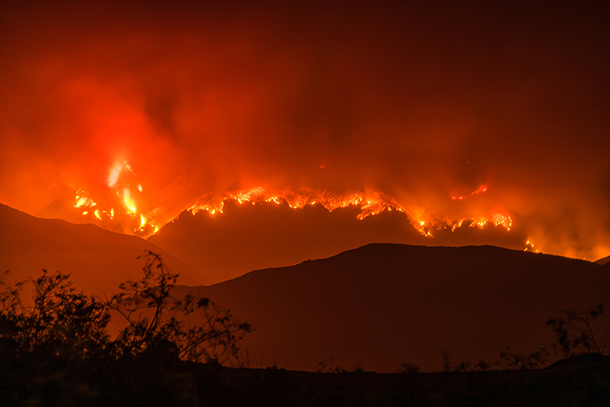
July 2017 Whittier Fire in Goleta, California (Photo: Glen Beltz, Flickr CC BY 2.0)
CURWOOD: It’s Living on Earth, I’m Steve Curwood. From much of the year, wildfires rip across the western United States, stretching through Canada and as far north as the forests of Alaska.
Wildfires once took hold only in hot, dry summer months, this year in the United States alone, more than two million acres of land were burned before the first day of spring. In its scramble to prevent and put out these blazes, the forest service now spends over 50% of its budget on wildfire fighting programs. This new, alarming situation has several causes, and a new book lays them out. It’s called “Land On Fire,” by nature writer Gary Ferguson, and he joins us now.
Gary, welcome to Living on Earth.
FERGUSON: Thank you, Steve. Great to be with you.
CURWOOD: So, why did you write this book?
FERGUSON: Well, Steve, when I was trained as a naturalist, way back when in the 1970s in the Sawtooth Mountains of Idaho, my mentor, who was a brilliant ecologist, happened to get me looking at landscape in terms of fire. Our landscapes throughout the country but especially in the American west have been really shaped by fire for thousands of years. Everything we see -- the shapes of the trees, the way they're clustered, the plants that grow there, the animals that exist -- have been shaped by fire.
What I started seeing though in the last 15 to 20 years especially is a different kind of fire roaring across the west. These are not the natural-stand maintenance fires that burned across thousands of years every 10 or 12 years to clean the forest and stem disease. These are bigger and hotter. They're coming more often, and they're having a pretty big consequence to both the landscape and the communities.

Author Gary Ferguson’s new book Land on Fire addresses the new extremes of wildfire in the western United States. (Photo: courtesy of Besse Lynch)
Let me mention very briefly two things are going on that sort of create a perfect storm right now in the American West. One is unnaturally heavy fuel load on about 300,000,000 acres, in other words, about three times the size of California that came from having about 80 years beginning in the 1915, 1920 era of overly heavy fire suppression, putting every fire that burned out as soon as we could. So, those fuel loads are meeting with climate change, and so when lightening strikes or a campfire is left unattended, we end up with a fire that's spreading very quickly, so this is a really, really different situation.
CURWOOD: In other words, this is not your grandmother's fire anymore, huh?
FERGUSON: You are so right. It is not your grandmother's fire. Yes, that's true. In fact, in the last 15 years, Steve, we've had so-called “mega fires,” which are gigantic fire events of 100,000 acres or more. We've had a dozen of those events in 12 of the last 15 years, so that's a profound difference as far as what was going on in the late 20th century.
CURWOOD: Now, right at the beginning of your book, Gary, you illustrate the sheer size and impact of a wildfire that really gets going and just blazes through one of America's western forests. Please paint a picture for us now of how a forest fire escalated from those few embers to a huge wildfire and then back to ash.
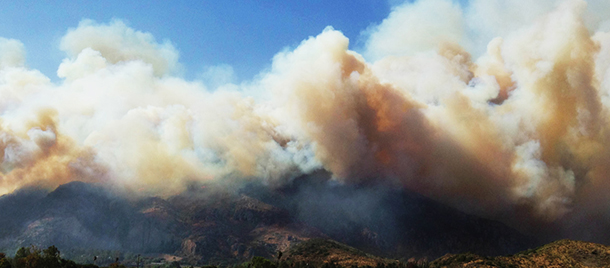
A Camarillo, California wildfire in early July 2017 swept over more than 50 acres of land (Photo: Hanlu Cao, Flickr CC BY 2.0)
FERGUSON: Well, typically there is an ignition source that's not as big as trees, and what I'm talking about are grasses. Many of the fires that are burning right now in California started as grass fires, either as grass understory in the forest or the edge of the forest, and then it moves into the trees. One thing about that, right now we have in large part because of drought conditions, a massive invasion of cheat grass, which is a non-native plant that drives out thoroughly by the middle of June and becomes almost like flash-paper. So, sometimes if you're in a cheat grass field -- and it's worth noting that 100,000,000 acres of the west are now in cheat grass -- that can torch off in very short order, and then it will come into the fuel load, the smaller twigs and branches that have fallen off the trees that, again, normally 200 years ago would've been cleaned out by these periodic, fairly low intensity fires burning through every 10 or 12 years. It gets into that and then from those smaller fuel loads it, especially if there are wind conditions that come up, then it can start actually burning up trees and crowning out as they call it, going all the way up the tree and completely consuming the tree, and from that point, depending on the topography and local wind conditions and so forth and, again, how dry it is.
The loss of humidity, even a couple of percentage points in humidity has a really big effect in making something combustible. There are places in the forest right now that have a percentage of dryness around 10 percent on the dead timber, and that's two percent less than what we would buy at the lumberyard to build our homes with, the two by fours. So, we're or talking about incredibly flammable materials.
CURWOOD: Back in 1910, you wrote about this huge fire that occurred. A lot lessons learned. But these big big fires coming much more often these days. To what extent can we look to climate change -- global warming -- as an impetus for this change in how fires are?
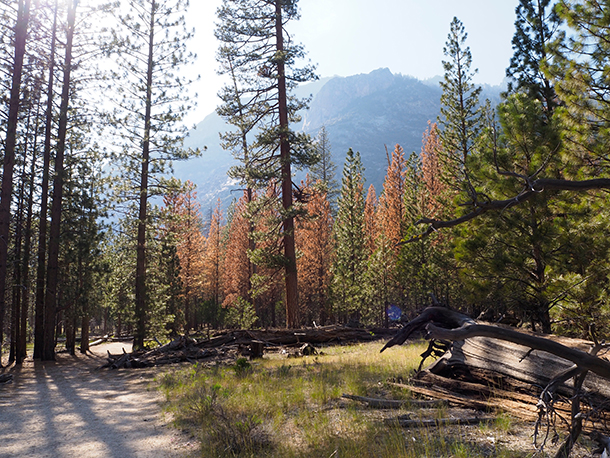
Evidence of the Pine Bark Beetle killing trees in Kings Canyon National Park, California and making them easy tinder for a megafire. (Photo: Laura Camp, Flickr CC BY-NC 2.0)
FERGUSON: It’s really quite profound. For starters, since 1972 our fire season has grown by about 75 days in the west. In fact, some places in the southwest are nearly to the point where they're having fire seasons all year long. One of the reasons that's happening is, with the warmer temperatures and the droughts also associated with human-caused climate change, the snow packs are going off earlier and, of course, as the snow pack go off, not only is there less water available to vegetation, but the ground itself is more exposed to sun and wind and dries out and becomes very, very flammable. The droughts I mentioned, there've been three major drought cycles in the west, significantly caused at least in part, not entirely but in part, by human-caused climate change.
Those droughts are stressing trees to the point where they're really, really susceptible to insect infestations. It's really sobering to consider that last year alone, 2016, California lost 60 million trees to drought or drought-related disease or insect infestation. That's a phenomenal tree kill. It's important to keep in mind that in the American west, things don't biodegrade the same way in the east because we have such a lack of moisture. So, the only way that the biomass, if you will, of trees and plants, returns to the soil is typically through fire. So, by putting those fires out, we really created that fuel load. This is why you're seeing many land managers pushing harder and harder for so called “prescribed burning,” where when it's safe to do so, they will light fires to mimic what nature used to do on her own before we started to interfere with her. Again, the heavy fuel loads that we created unwittingly in the 20th century by putting out every maintenance fire, if you will, created a bad situation, as far as what's there to burn.
CURWOOD: By the way, what is a maintenance fire?
FERGUSON: A maintenance fire, and the actual full term is called by ecologists, “stand maintenance fire.” It really refers to a natural burn that was a part of the western landscape for, for thousands of years that would touch off 8, 10 or 12 years or so, usually by lightning, and it would burn at a fairly low intensity. So, we're talking six to eight foot high flames, 1,200 degree temperatures. Now, if you compare that to a megafire, we might have 150 foot flames, 2,000, 2,200 degree temperatures, but these stand maintenance fires would come through and clean up those smaller trees that had fallen and branches that had fallen, clean up the dry grass, stem the insect invasions, and then they would be gone, and we be left with a healthier forest.
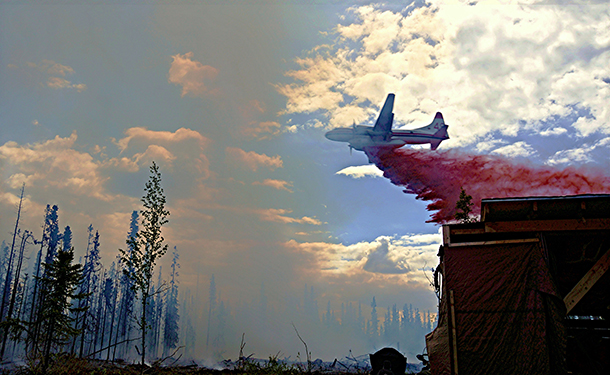
An airplane helps contain an Alaskan forest fire by dropping borate salt fire retardant. (Photo: JLS Photography – Alaska, Flickr CC BY-NC-ND 2.0)
CURWOOD: Yes, you write about the Pine Bark beetle and other critters that go in and kill trees, and I believe at one point in your book you say that these insect infestations which have been accelerated by drought have become even more important than lightning strikes that typically would set off forest fires.
FERGUSON: Well, it's interesting. The Pine Bark beetle, especially, it's been with the western forest for a very very long time, but it used to be that winter temperatures were cold enough to limit the spread of the Pine Bark beetle to kill off the populations. Now that's not the case anymore. In fact, not only are they not being killed off, but they've managed to double their reproduction rate in a given summer. So, this creates a lot more insects.
Meanwhile, if you're an insect attacking, say, a Lodgepole pine during a drought, the Lodgepole pine would normally have defenses to release a lot of pitch and literally what they call "pitch out" the insects from the invasion. But, with drought, that moisture is no longer available, so it's much easier for those insects to make their way into the trees. And then, as a lightning strike hits or a campfire or a chainsaw spark or something like that, again we got these big fuel loads met up with tremendous climate change consequences, and even winds have picked up in some places and, of course, winds can be really dangerous ingredient for a wildfire, especially a megafire that's over 100,000 acres. Very dangerous to housing subdivisions and, of course, very, very dangerous to the men and women who are fighting fires.
CURWOOD: So, let me add these factors up that you present in your book, Gary. So, there is more fuel because of fire suppression that is available in many of these forests, A. B, with things getting warmer and the climate, the bugs that attack trees aren't getting killed as much in the wintertime, so they can kill trees and, of course, a dead or nearly dead dry tree is much more susceptible to fire, and then you say that the trees themselves because of the drought their typical defenses aren't working all that great, and overall it's a bit warmer. Sounds like the perfect storm or should I say, the perfect firestorm?
FERGUSON: Yes, it really is, Steve, a perfect firestorm. That's a great term for it, and one other thing to add in the mix as if we didn't already have enough, and that's the fact that in areas in United States that are often referred to as wildland urban interface, and what this means -- It's a complicated title that just means housing developments and businesses that come up against large slices of natural vegetation -- and It's really quite amazing. 60 percent of the homes that have been built in the United States since 2006 have been in this wildland urban interface and some 200,000,000 acres right now are considered at high fire risk. That's where the development is going and unfortunately too often we're doing developments in a way that just are not so called “fire-wise.”
CURWOOD: Hey, Gary, how many people here in United States live in what you call this wildland urban interface in the west there?
FERGUSON: Well, amazingly, it's just about a third of the population of the country, over 100-million people living in a wildland urban interface. Again a significant portion of that interface is already mapped as high fire danger, about 70,000 communities, we could think of in those terms as well. And of the 70,000, it's worth mentioning that only three percent so far have done steps -- and they are relatively simple steps -- and they're very effective. They're not fireproof but to leave their communities more fire resistant.
CURWOOD: So, talk me through what people living in this high-risk area of wildfire there in the west, this wildland urban interface. What are the steps that individuals should take, and then what are things that communities should do in light of the reality of the changing fire regime?
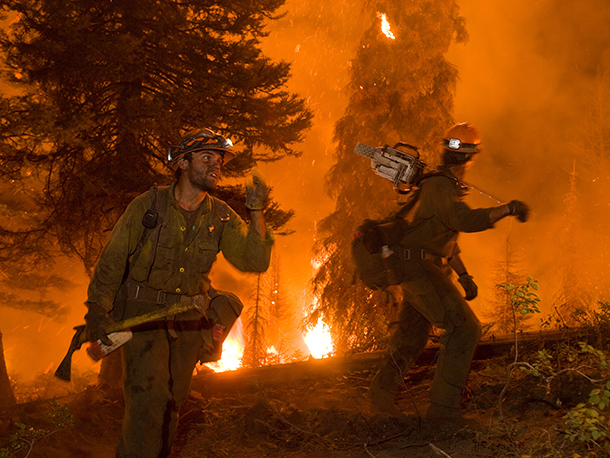
Two members of the Idaho City Hotshots work on the Springs Fire on the Boise National Forest in August 2012. (Photo: U.S. Department of Agriculture, Flickr CC BY 2.0)
FERGUSON: Well, there are some wonderful efforts going on right now in Colorado, groups coming together in neighborhoods forming what are called s”aws and slaws,” and so they basically have a local firefighter or forest service official come and help them with thinning the forest around the subdivision so that they can have less of a chance of a fire raging into their housing development, and the slaws part is after they're done cutting the trees they have a picnic with beer and coleslaw and whatever, and it has been a way to bring communities together.
As far as individual homes, very simple things: Taking a five-foot perimeter around your house and covering it with nonflammable material. Putting screen mesh over attic vents; going around and giving the firefighters basically a 40 to 50 foot defensible perimeter, it's called, by cutting errant bushes and smaller trees away and just by doing that, this may seem like it wouldn't make a lot of difference, but to give you an example, in the Black Forest Fire a few years ago in Colorado Springs, one subdivision that had done those things experienced a home loss of four homes out of 69. Right next door, there was another subdivision that hadn't done anything. They lost 61 homes out of 67. So, it really, really can make a difference, a very big difference.
CURWOOD: So, this business of fighting fires, protecting lives and homes and such, is expensive. How expensive is it, and how is the federal government which I gather does most of the fire fighting in the west, how is the federal government doing in terms of managing the economic impact of all this?
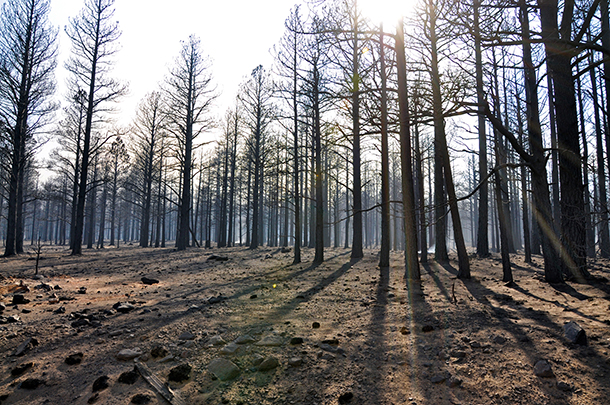
The aftermath of the 2010 Schultz Fire in the Coconino National Park, Arizona, which burned more than 15,000 acres of forest. (Photo: Coconino National Forest, Flickr CC BY-SA 2.0)
FERGUSON: Well, it's, it's been devastating, especially to the Forest Service. Forest Service can, in some years, spend between 70 and 90 percent of their budget on fighting fires. That means nothing else for fire prevention or, you know, fire-thinning and other forest treatments. It's a price tag on about $3 billion dollars a year in hearty fire season, and that's what we're getting more of than not these days. What we have right now is the Forest Service and the taxpayers, of course, who fund them, spending all of that money to fight fires in developments that shouldn't have been developed the way they were. And so at some point, besides offering county commissioners incentives for doing it right, there are some people talking about, we need to also perhaps give them some of the burden of the cost of suppressing fires, especially in developments that were simply not designed properly, knowing what we know now.
CURWOOD: And Gary, at one point in your book you write that this situation may turn around, but unlikely in our lifetimes, that we are entering a new normal. We're already in it. It's probably going to get worse before it gets better. So, what can you say to encourage folks about this problem? Where is the bright side of this?
FERGUSON: Well, one thing I would love to see happen that's very practical, there's a bill in the house of representatives, House Bill 167 that has been sitting there for two-and-a-half years that would give the Forest Service access to emergency funds in high fire years, much like FEMA steps in after a hurricane or a tornado or a flood. Right now the Forest Service only has its own budget to spend, and sometimes it's inadequate, and it again cuts them off from that process of educating and going out and helping people thin the woods, do prescribed burns to make these forests less flammable, less likely to burst into a megafire in the years to come. We also, quite frankly, really need to take climate change very seriously and start embracing alternative technologies, look at our carbon footprint, endorse regenerative agriculture that holds crops in the grounds that become carbon sequestration.
These are all very important things. We got the smarts. We've got all we need to know to actually do these things. We just simply have to have a heart and the will at this point, and, I think, as fires continue to rage in and a bigger and bolder fashion, they will continue to knock on our door trying to get our attention to take all of this very seriously.
CURWOOD: Gary Ferguson is a best-selling nature writer and author of the new book, "Land on Fire: The Reality of Wildfire in the West.” Gary, thanks so much for taking the time with me today.
FERGUSON: It's been a pleasure. Thank you, Steve.
Related links:
- More about Gary Ferguson on his website, Wildwords
- Land on Fire: The New Reality of Wildfire in the West
- Interactive map of current wildfires burning in the United States
[MUSIC: Tommy Flanagan & Hank Jones, “A Child Is Born” on Our Delights, Original Jazz Classics]
CURWOOD: Next time on Living on Earth, some pollutants are for the neighborhood, and some are for the whole planet.
SIMONICH: We're a connected atmosphere, right? What happens in one part of the world impacts other parts of the world. So, we're all united in one atmosphere.
CURWOOD: A world of dirty air and possible health problems. That’s next time on Living on Earth.
[MUSIC: Tommy Flanagan & Hank Jones, “A Child Is Born” on Our Delights, Original Jazz Classics]
[SOUNDS OF AUKLETS CALLING]
CURWOOD: We leave you this week in the company of some extraordinary creatures and their babies.
[BIRD CALLS, RHINOCEROS AUKLETS]
CURWOOD: These are several rhinoceros auklets with their chicks, recorded at Protection Island National Wildlife Refuge in the Strait of Juan de Fuca off the Pacific Coast. Rhinoceros Auklets are relatives of puffins, medium sized dark grey duck-like birds that spend their days at sea, and then return at night with fish for their single chick hiding deep in a burrow.
[MORE RHINOCEROS AUKLET CALLS]
CURWOOD: Jeff Rice recorded these birds in the middle of a July night, with support from the Acoustic Atlas at Montana State University.
[MUSIC Johnny Flynn “The Box” on A Larum, Mercury Records]
CURWOOD: Living on Earth is produced by the World Media Foundation. Our crew includes Naomi Arenberg, Bobby Bascomb, Savannah Christiansen, Jenni Doering, Matt Hoisch, Noble Ingram, Jaime Kaiser, Don Lyman, Lizz Malloy, Helen Palmer, Olivia Reardon, Rebecca Redelmeier, Adelaide Chen, and Jolanda Omari. Tom Tiger, Jake Rego and John Jessoe engineered our show. Special thanks this week to Caitlin Plummer and Rebecca Gibian and Reveal from the Center for Investigative Reporting. Alison Lirish Dean composed our themes. You can hear us anytime at loe.org - and like us, please, on our Facebook page -- PRI’s Living on Earth. And we tweet from @livingonearth. I’m Steve Curwood. Thanks for listening!
ANNOUNCER1: Funding for Living on Earth comes you, our listeners, and from the University of Massachusetts, Boston, in association with its School for the Environment, developing the next generation of environmental leaders. And from the Grantham Foundation for the protection of the environment, supporting strategic communications and collaboration in solving the world’s most pressing environmental problems. Support also comes from the Energy Foundation, serving the public interest by helping to build a strong, clean energy economy, from Carl and Judy Ferenbach of Boston, Massachusetts and from SolarCity, America’s solar power provider. SolarCity is dedicated to revolutionizing the way energy is delivered by giving customers a renewable alternative to fossil fuels. Information at 888-997-1703. That’s 888-997-1703.
ANNOUNCER2: PRI. Public Radio International.
Living on Earth wants to hear from you!
Living on Earth
62 Calef Highway, Suite 212
Lee, NH 03861
Telephone: 617-287-4121
E-mail: comments@loe.org
Newsletter [Click here]
Donate to Living on Earth!
Living on Earth is an independent media program and relies entirely on contributions from listeners and institutions supporting public service. Please donate now to preserve an independent environmental voice.
NewsletterLiving on Earth offers a weekly delivery of the show's rundown to your mailbox. Sign up for our newsletter today!
 Sailors For The Sea: Be the change you want to sea.
Sailors For The Sea: Be the change you want to sea.
 The Grantham Foundation for the Protection of the Environment: Committed to protecting and improving the health of the global environment.
The Grantham Foundation for the Protection of the Environment: Committed to protecting and improving the health of the global environment.
 Contribute to Living on Earth and receive, as our gift to you, an archival print of one of Mark Seth Lender's extraordinary wildlife photographs. Follow the link to see Mark's current collection of photographs.
Contribute to Living on Earth and receive, as our gift to you, an archival print of one of Mark Seth Lender's extraordinary wildlife photographs. Follow the link to see Mark's current collection of photographs.
 Buy a signed copy of Mark Seth Lender's book Smeagull the Seagull & support Living on Earth
Buy a signed copy of Mark Seth Lender's book Smeagull the Seagull & support Living on Earth

